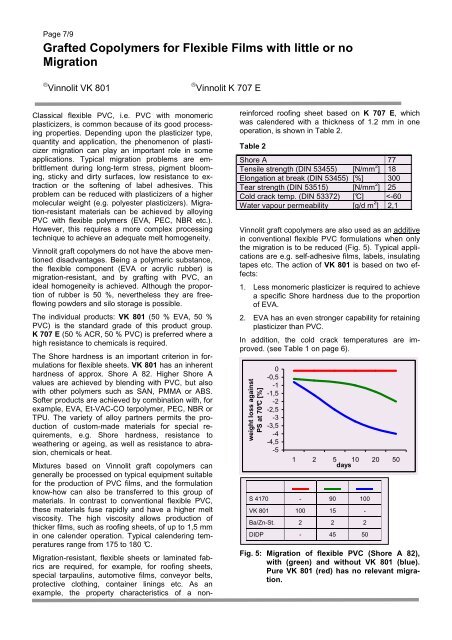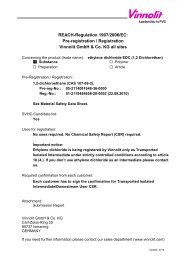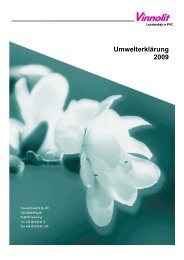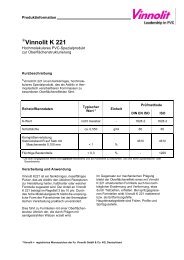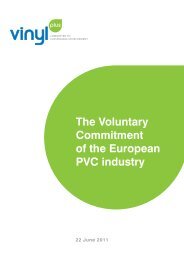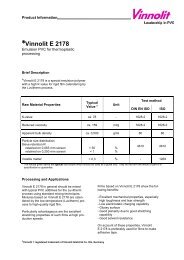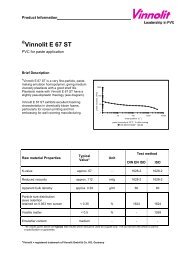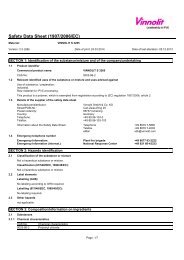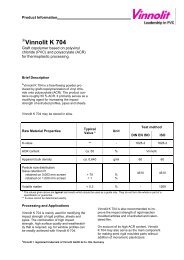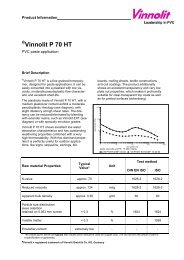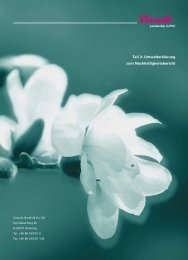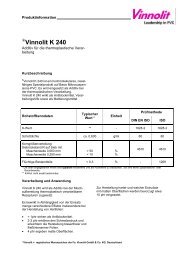PVC Products for the Production of Rigid Films - Vinnolit
PVC Products for the Production of Rigid Films - Vinnolit
PVC Products for the Production of Rigid Films - Vinnolit
- No tags were found...
Create successful ePaper yourself
Turn your PDF publications into a flip-book with our unique Google optimized e-Paper software.
Page 7/9Grafted Copolymers <strong>for</strong> Flexible <strong>Films</strong> with little or noMigration® <strong>Vinnolit</strong> VK 801® <strong>Vinnolit</strong> K 707 EClassical flexible <strong>PVC</strong>, i.e. <strong>PVC</strong> with monomericplasticizers, is common because <strong>of</strong> its good processingproperties. Depending upon <strong>the</strong> plasticizer type,quantity and application, <strong>the</strong> phenomenon <strong>of</strong> plasticizermigration can play an important role in someapplications. Typical migration problems are embrittlementduring long-term stress, pigment blooming,sticky and dirty surfaces, low resistance to extractionor <strong>the</strong> s<strong>of</strong>tening <strong>of</strong> label adhesives. Thisproblem can be reduced with plasticizers <strong>of</strong> a highermolecular weight (e.g. polyester plasticizers). Migration-resistantmaterials can be achieved by alloying<strong>PVC</strong> with flexible polymers (EVA, PEC, NBR etc.).However, this requires a more complex processingtechnique to achieve an adequate melt homogeneity.<strong>Vinnolit</strong> graft copolymers do not have <strong>the</strong> above mentioneddisadvantages. Being a polymeric substance,<strong>the</strong> flexible component (EVA or acrylic rubber) ismigration-resistant, and by grafting with <strong>PVC</strong>, anideal homogeneity is achieved. Although <strong>the</strong> proportion<strong>of</strong> rubber is 50 %, never<strong>the</strong>less <strong>the</strong>y are freeflowingpowders and silo storage is possible.The individual products: VK 801 (50 % EVA, 50 %<strong>PVC</strong>) is <strong>the</strong> standard grade <strong>of</strong> this product group.K 707 E (50 % ACR, 50 % <strong>PVC</strong>) is preferred where ahigh resistance to chemicals is required.The Shore hardness is an important criterion in <strong>for</strong>mulations<strong>for</strong> flexible sheets. VK 801 has an inherenthardness <strong>of</strong> approx. Shore A 82. Higher Shore Avalues are achieved by blending with <strong>PVC</strong>, but alsowith o<strong>the</strong>r polymers such as SAN, PMMA or ABS.S<strong>of</strong>ter products are achieved by combination with, <strong>for</strong>example, EVA, Et-VAC-CO terpolymer, PEC, NBR orTPU. The variety <strong>of</strong> alloy partners permits <strong>the</strong> production<strong>of</strong> custom-made materials <strong>for</strong> special requirements,e.g. Shore hardness, resistance towea<strong>the</strong>ring or ageing, as well as resistance to abrasion,chemicals or heat.Mixtures based on <strong>Vinnolit</strong> graft copolymers cangenerally be processed on typical equipment suitable<strong>for</strong> <strong>the</strong> production <strong>of</strong> <strong>PVC</strong> films, and <strong>the</strong> <strong>for</strong>mulationknow-how can also be transferred to this group <strong>of</strong>materials. In contrast to conventional flexible <strong>PVC</strong>,<strong>the</strong>se materials fuse rapidly and have a higher meltviscosity. The high viscosity allows production <strong>of</strong>thicker films, such as ro<strong>of</strong>ing sheets, <strong>of</strong> up to 1,5 mmin one calender operation. Typical calendering temperaturesrange from 175 to 180 °C.Migration-resistant, flexible sheets or laminated fabricsare required, <strong>for</strong> example, <strong>for</strong> ro<strong>of</strong>ing sheets,special tarpaulins, automotive films, conveyor belts,protective clothing, container linings etc. As anexample, <strong>the</strong> property characteristics <strong>of</strong> a nonrein<strong>for</strong>cedro<strong>of</strong>ing sheet based on K 707 E, whichwas calendered with a thickness <strong>of</strong> 1.2 mm in oneoperation, is shown in Table 2.Table 2Shore A 77Tensile strength (DIN 53455) [N/mm 2 ] 18Elongation at break (DIN 53455) [%] 300Tear strength (DIN 53515) [N/mm 2 ] 25Cold crack temp. (DIN 53372) [°C]


